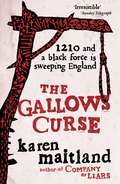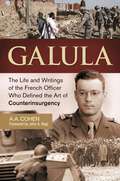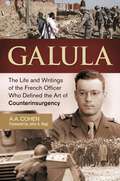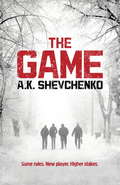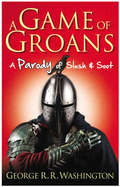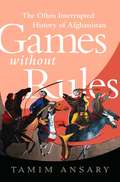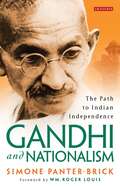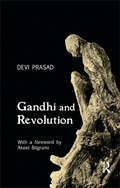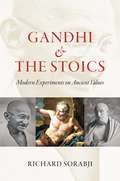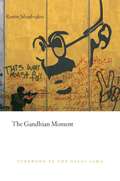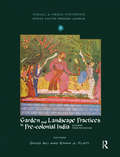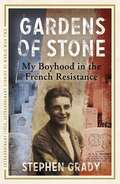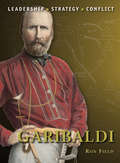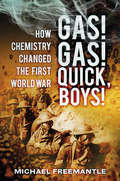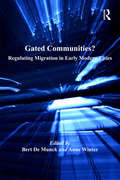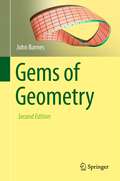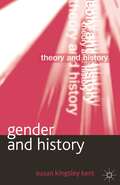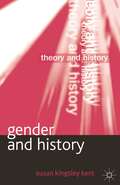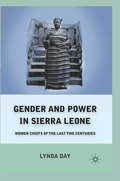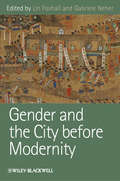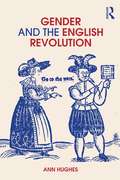- Table View
- List View
The Gallows Curse
by Karen Maitland1210 and a black force is sweeping England. For a vengeful King John has seized control of the Church, leaving corpses to lie in unconsecrated ground, babies unbaptized in their cradles and the people terrified of dying in sin. And in the village of Gastmere, the consequences grow darker still when Elena, a servant girl, is dragged into a conspiracy to absolve the sins of the lord of the manor. As the terrors that soon begin to plague Elena's sleep grow darker, in desperation she visits the cunning woman, who has been waiting for just such an opportunity to fulfil an ancient curse conjured at the gallows.Elena, haunted by this curse and threatened with death for a crime she didn't commit, flees the village ... only to find her nightmare has barely begun.For treachery lurks in every shadow as King John's brutal reign makes enemies of brothers, murderers of virgins and sinners of us all.
Galula: The Life and Writings of the French Officer Who Defined the Art of Counterinsurgency
by A A. CohenThis comprehensive analytical biography is the definitive work on the life and writings of history's most significant counterinsurgency doctrinaire, David Galula, elucidating the context for his reflections and examining the present and future applicability of his treatise for scholars and practitioners alike.The product of years of extensive research made possible by exclusive access to Galula's personal papers as well as first-hand accounts from colleagues, family members, and friends, this book traces Galula's life from early childhood until death, describing his upbringing, education, and military career in the tumultuous historical context of his era. The author—a former counterinsurgency practitioner himself—pays particular attention to how the Chinese Revolution and the Algerian War affected Galula's views, and identifies Galula's mentors and the schools of thought within the French military that greatly influenced his writings. A conclusion illuminates the contemporary and likely future validity of his works. In the epilogue, the author speaks to Galula's influence over modern military thought and U.S. counterinsurgency doctrine. This book is essential reading for individuals with an interest in counterinsurgency, Galula's writings, or Galula himself, such as military officers and civilian administrators undertaking counterinsurgency courses and training.
Galula: The Life and Writings of the French Officer Who Defined the Art of Counterinsurgency
by A A. CohenThis comprehensive analytical biography is the definitive work on the life and writings of history's most significant counterinsurgency doctrinaire, David Galula, elucidating the context for his reflections and examining the present and future applicability of his treatise for scholars and practitioners alike.The product of years of extensive research made possible by exclusive access to Galula's personal papers as well as first-hand accounts from colleagues, family members, and friends, this book traces Galula's life from early childhood until death, describing his upbringing, education, and military career in the tumultuous historical context of his era. The author—a former counterinsurgency practitioner himself—pays particular attention to how the Chinese Revolution and the Algerian War affected Galula's views, and identifies Galula's mentors and the schools of thought within the French military that greatly influenced his writings. A conclusion illuminates the contemporary and likely future validity of his works. In the epilogue, the author speaks to Galula's influence over modern military thought and U.S. counterinsurgency doctrine. This book is essential reading for individuals with an interest in counterinsurgency, Galula's writings, or Galula himself, such as military officers and civilian administrators undertaking counterinsurgency courses and training.
The Game
by A.K. ShevchenkoA taut thriller set against the turbulent history of Ukraine and the Crimea, giving fascinating and thought-provoking insight into the country's current crisis.It has been twenty-five years since the four friends left school, burdened with the dark secret of a game that ended in tragedy. Now, driven by love, loss and loyalty, they meet to play Tony's game once more. Tony, the mastermind, has planned the moves that will take each player across continents. The rules are the same, but they have grown up, and the stakes are much, much higher. They will be forced to open a forgotten page of history: the Crimea conference of 1945, where three world leaders divided up the world and created a new map of Europe after the Second World War. How are the secret talks of those leaders connected with this dangerous new game? And why has Tony decided to play again?
A Game of Groans: A Sonnet Of Slush And Soot
by George R. Washington‘There was a bloodied knife on Allbran’s bed. Lady Gateway Barker knew what she had to do; what all the royals in Summerseve did when somebody tried to kill a member of their family: gather up a bunch of people and horses, and go from one place to another.’This is the hilarious parody of the George R. R. Martin bestseller A Game of Thrones.
Games without Rules: The Often-Interrupted History of Afghanistan
by Tamim AnsaryBy the author of Destiny Disrupted: An enlightening, lively, accessible, history of Afghanistan from 1840 to today, from the Afghan point of view, that illuminates how Great Power conflicts have interrupted an ongoing, internal struggle to take form as a nation. Five times in the last two centuries, some great power has tried to invade, occupy, or otherwise take control of Afghanistan. And as Tamim Ansary shows in this illuminating history, every intervention has come to grief in much the same way and for much the same reason: The intervening power has failed to understand that Afghanistan has a story of its own, a story that continues to unfold between, and despite, the interventions. Games without Rules tells this story from the inside looking out. Drawing on his Afghan background, Muslim roots, and Western and Afghan sources, Ansary weaves an epic that moves from a universe of village republics--the old Afghanistan--through a tumultuous drama of tribes, factions, and forces, to the current struggle. Ansary paints a richly textured portrait of a nation that began to form around the same time as the United States but is still struggling to coalesce; a nation driven by its high ambitions but undermined by its own demons, while every forty to sixty years a great power crashes in and disrupts whatever progress has been made. A compelling narrative told in an accessible, conversational style, Games without Rules offers revelatory insight into a country long at the center of international debate, but never fully understood by the outside world.
Gandhi and Nationalism: The Path to Indian Independence
by Simone Panter-BrickGandhi's nationalism seems simple and straightforward: he wanted an independent Indian nation-state and freedom from British colonial rule. But in reality his nationalism rested on complex and sophisticated moral philosophy. His Indian state and nation were based on no shallow ethnic or religious communalism, despite his claim to be Hindu to his very core, but were grounded on his concept of swaraj - enlightened self-control and self-development leading to harmony and tolerance among all communities in the new India. He aimed at moral regeneration, not just the ending of colonial rule. Simone Panter-Brick's perceptive and original portrayal of Gandhi's nationalism analyses his spiritual and political programme. She follows his often tortuous path as a principal, spiritual and political leader of the Indian Congress, through his famous campaigns of non-violent resistance and negotiations with the Government of India leading to Independence and, sadly for Gandhi, the Partition in 1947. Gandhi's nationalism was, in Wm. Roger Louis's phrase, 'larger than the struggle forindependence'. He sought a tolerant and unified state that included all communities within a 'Mother India'.Panter-Brick's work will be essential reading for all scholars and students of Indian history and political ideas.
Gandhi and Revolution
by Devi PrasadThis volume is a collection of Devi Prasad’s essays on Gandhi, social justice and social change. The different essays address themes ranging from Gandhi’s ideals of satyagraha and ahimsa, civil disobedience and non-violence, to the Gandhian approach to education as founded in making and crafting as well as participation in the political and social movements of our times. They also engage the revolutionary potential of Gandhi’s thought, drawing parallels between Lenin and Gandhi and analysing the historical significance of Gandhi’s anti-imperialist yet non-violent political philosophy. In sum, the volume dwells on the continuing, critical relevance of Gandhi in our times. It will be of interest to those in education, political science, peace and conflict studies, history and philosophy, as well as to the general reader interested in Gandhian thought.
Gandhi and Revolution
by Devi PrasadThis volume is a collection of Devi Prasad’s essays on Gandhi, social justice and social change. The different essays address themes ranging from Gandhi’s ideals of satyagraha and ahimsa, civil disobedience and non-violence, to the Gandhian approach to education as founded in making and crafting as well as participation in the political and social movements of our times. They also engage the revolutionary potential of Gandhi’s thought, drawing parallels between Lenin and Gandhi and analysing the historical significance of Gandhi’s anti-imperialist yet non-violent political philosophy. In sum, the volume dwells on the continuing, critical relevance of Gandhi in our times. It will be of interest to those in education, political science, peace and conflict studies, history and philosophy, as well as to the general reader interested in Gandhian thought.
Gandhi and the Stoics: Modern Experiments on Ancient Values
by Richard Sorabji“Was Gandhi a philosopher? Yes.” So begins this remarkable investigation of the guiding principles that motivated the transformative public acts of one of the top historical figures of the twentieth century. Richard Sorabji, continuing his exploration of the many connections between South Asian thought and ancient Greek and Roman philosophy, brings together in this volume the unlikely pairing of Mahatma Gandhi and the Stoics, uncovering a host of parallels that suggests a deep affinity spanning the two millennia between them. While scholars have long known Gandhi’s direct Western influences to be Platonic and Christian, Sorabji shows how a look at Gandhi’s convergence with the Stoics works mutually, throwing light on both of them. Both emphasized emotional detachment, which provided a necessary freedom, a suspicion of universal rules of conduct that led to a focus not on human rights but human duties—the personally determined paths each individual must make for his or her self. By being indifferent, paradoxically, both the Stoics and Gandhi could love manifoldly. In drawing these links to the fore, Sorabji demonstrates the comparative consistency of Gandhi’s philosophical ideas, isolating the specific ideological strengths that were required to support some of the most consequential political acts and experiments in how to live.
The Gandhian Moment
by Ramin JahanbeglooThe father of Indian independence, Gandhi was also a political theorist who challenged mainstream ideas. Sovereignty, he said, depends on the consent of citizens willing to challenge the state nonviolently when it acts immorally. The culmination of the inner struggle to recognize one’s duty to act is the ultimate “Gandhian moment.”
Garden and Landscape Practices in Pre-colonial India: Histories from the Deccan (Visual and Media Histories)
by Daud Ali Emma J. FlattThis book presents a set of new and innovative essays on landscape and garden culture in precolonial India, with a special focus on the Deccan. Most research to date has concentrated on the comparatively well preserved gardens and built landscapes of the celebrated Mughal empire, giving the impression that they have been lacking in other times and regions. Not only does this volume provide a corrective to such assumptions, it also moves away from traditional art-historical approaches by posing new questions and exploring hitherto neglected source materials. The contributors understand gardens in two related ways: first as real or imagined spaces and manipulated landscapes that are often invested with pronounced semiotic density; and second as congeries of institutions and practices with far-reaching social ramifications for the constitution of elite societies. The essays here present a multi-disciplinary approach to the study of garden culture in precolonial India, and together suggest several new and exciting directions of enquiry for those working in the Deccan, Mughal India, and beyond.
Garden and Landscape Practices in Pre-colonial India: Histories from the Deccan (Visual and Media Histories)
by Daud Ali; Emma J. FlattThis book presents a set of new and innovative essays on landscape and garden culture in precolonial India, with a special focus on the Deccan. Most research to date has concentrated on the comparatively well preserved gardens and built landscapes of the celebrated Mughal empire, giving the impression that they have been lacking in other times and regions. Not only does this volume provide a corrective to such assumptions, it also moves away from traditional art-historical approaches by posing new questions and exploring hitherto neglected source materials. The contributors understand gardens in two related ways: first as real or imagined spaces and manipulated landscapes that are often invested with pronounced semiotic density; and second as congeries of institutions and practices with far-reaching social ramifications for the constitution of elite societies. The essays here present a multi-disciplinary approach to the study of garden culture in precolonial India, and together suggest several new and exciting directions of enquiry for those working in the Deccan, Mughal India, and beyond.
Gardens of Stone: My Boyhood in the French Resistance (Extraordinary Lives, Extraordinary Stories of World War Two)
by Michael Wright Stephen GradyAn extraordinary wartime memoir, combining the best kind of adventure story with a coming of age testimony of unforgettable resonance and poignancy. September 2011, Halkidiki, Northern Greece. A solitary 86 year-old man gazes across an Aegean headland, knowing that he must finally confront his past. He begins to write... September 1939, Nieppe, Northern France. 14 year-old Stephen is living with his family, 25 kilometres from Ypres. His French mother battles with her encroaching blindness. Failing to escape the advancing German army, his English father can no longer look after the war graves that cast so heartbreaking a shadow across the region. Stephen and his friend Marcel embark upon their great adventure: collecting souvenirs from strafed convoys and crashed Messerschmitts. But their world turns dark when arrested and imprisoned for sabotage and threatened with deportation or the firing squad. Upon his release, and still only 16, Stephen is recruited by the French Resistance. Growing up under the threat of imminent betrayal, he learns the arts of clandestine warfare, and - in a moment that haunts him still - how to kill... Such was the impact of Stephen Grady's work for the French Resistance, (especially during the countdown to D-Day and its bloody aftermath) that he was awarded the Croix de Guerre and the American Medal of Freedom.
Garibaldi: Leadership, Strategy, Conflict (Command #14)
by Peter Dennis Ron FieldThis book looks closely at the life, military experiences and key battlefield exploits of Giuseppe Garibaldi. Born on 4 July 1807 in the city of Nice, the turning point in his life occurred in April 1833 when he met Giovanni Battista Cuneo, a member of the secret movement known as 'Young Italy'. Joining this society, Garibaldi took an oath dedicating his life to the struggle for the liberation of his homeland from Austrian dominance. The subsequent years would see him fighting in Brazil, in the Uruguayan Civil War, and on the Italian peninsula. Between 1848 and 1870, Garibaldi and his men were involved in a prolonged struggle that eventually led to the final unification of Italy in 1870.
Gas! Gas! Quick, Boys: How Chemistry Changed the First World War
by Michael FreemantleGas! GAS! Quick, boys! reveals for the first time the true extent of how chemistry rather than military strategy determined the shape, duration and outcome of the First World War. Chemistry was not only a destructive instrument of war but also protected troops, and healed the sick and wounded. From bombs to bullets, poison gas to anaesthetics, khaki to cordite, chemistry was truly the alchemy of the First World War. Michael Freemantle explores its dangers and its healing potential, revealing how the arms race was also a race for chemistry to the extent that Germany's thirst for the chemicals needed to make explosives deprived the nation of fertilizers and nearly starved the nation. He answers question such as: What is guncotton? What is lyddite? What is mustard gas? What is phosgene? What is gunmetal? This is a true picture of the horrors of the 'Chemists' War'.
Gated Communities?: Regulating Migration in Early Modern Cities
by Anne WinterContrary to earlier views of preindustrial Europe as an essentially sedentary society, research over the past decades has amply demonstrated that migration was a pervasive characteristic of early modern Europe. In this volume, the theme of urban migration is explored through a series of historical contexts, journeying from sixteenth-century Antwerp, Ulm, Lille and Valenciennes, through seventeenth-century Berlin, Milan and Rome, to eighteenth-century Strasbourg, Trieste, Paris and London. Each chapter demonstrates how the presence of diverse and often temporary groups of migrants was a core feature of everyday urban life, which left important marks on the demographic, economic, social, political, and cultural characteristics of individual cities. The collection focuses on the interventions by urban authorities and institutions in a wide-ranging set of domains, as they sought to stimulate, channel and control the newcomers' movements and activities within the cities and across the cities' borders. While striving for a broad geographical and chronological coverage in a comparative perspective, the volume aims to enhance our insight into the different factors that shaped urban migration policies in different European settings west of the Elbe. By laying bare the complex interactions of actors, interests, conflicts, and negotiations involved in the regulation of migration, the case studies shed light on the interrelations between burghership, guilds, relief arrangements, and police in the incorporation of newcomers and in shaping the shifting boundaries between wanted and unwanted migrants. By relating to a common analytical framework, presented in the introductory chapter, they engage in a comparative discussion that allows for the formulation of general insights and the identification of long term transformations that transcend the time and place specificities of the case studies in question. The introduction and final chapters connect insights derived from the individual case-study chapters to present wide ranging conclusions that resonate with both historical and present-day debates on migration.
Gated Communities?: Regulating Migration in Early Modern Cities
by Anne WinterContrary to earlier views of preindustrial Europe as an essentially sedentary society, research over the past decades has amply demonstrated that migration was a pervasive characteristic of early modern Europe. In this volume, the theme of urban migration is explored through a series of historical contexts, journeying from sixteenth-century Antwerp, Ulm, Lille and Valenciennes, through seventeenth-century Berlin, Milan and Rome, to eighteenth-century Strasbourg, Trieste, Paris and London. Each chapter demonstrates how the presence of diverse and often temporary groups of migrants was a core feature of everyday urban life, which left important marks on the demographic, economic, social, political, and cultural characteristics of individual cities. The collection focuses on the interventions by urban authorities and institutions in a wide-ranging set of domains, as they sought to stimulate, channel and control the newcomers' movements and activities within the cities and across the cities' borders. While striving for a broad geographical and chronological coverage in a comparative perspective, the volume aims to enhance our insight into the different factors that shaped urban migration policies in different European settings west of the Elbe. By laying bare the complex interactions of actors, interests, conflicts, and negotiations involved in the regulation of migration, the case studies shed light on the interrelations between burghership, guilds, relief arrangements, and police in the incorporation of newcomers and in shaping the shifting boundaries between wanted and unwanted migrants. By relating to a common analytical framework, presented in the introductory chapter, they engage in a comparative discussion that allows for the formulation of general insights and the identification of long term transformations that transcend the time and place specificities of the case studies in question. The introduction and final chapters connect insights derived from the individual case-study chapters to present wide ranging conclusions that resonate with both historical and present-day debates on migration.
Gems of Geometry
by John BarnesBased on a series of lectures for adult students, this lively and entertaining book proves that, far from being a dusty, dull subject, geometry is in fact full of beauty and fascination. The author's infectious enthusiasm is put to use in explaining many of the key concepts in the field, starting with the Golden Number and taking the reader on a geometrical journey via Shapes and Solids, through the Fourth Dimension, finishing up with Einstein's Theories of Relativity. Equally suitable as a gift for a youngster or as a nostalgic journey back into the world of mathematics for older readers, John Barnes' book is the perfect antidote for anyone whose maths lessons at school are a source of painful memories. Where once geometry was a source of confusion and frustration, Barnes brings enlightenment and entertainment. In this second edition, stimulated by recent lectures at Oxford, further material and extra illustrations have been added on many topics including Coloured Cubes, Chaos and Crystals.
Gender and History (Theory and History)
by Susan Kingsley KentWhat is gender and who has it? History, theory and gender are inextricably linked, but how exactly do they fit together? How dohistorians use theories about gender to write history? In this jargon-free introduction, Susan Kingsley Kent presents a student-friendly guide to the origins, conceptual framework, subjectmatter and methods of gender history. Assuming no prior knowledge, Gender and History: ? sets out clear definitions of theory, history and gender? explains that gender is not solely applicable to women, but to men as well? tackles the hotly debated topic of power and gender relations? explores gender history from a variety of angles, including anthropology, psychology and philosophy? spans a broad chronological period, from the times of Aristotle to the present day? includes a helpful glossary that explains key terms and concepts at a glance. Lively and approachable, this is an essential text for anyone who wishes to learn how to use theories of gender in their historicalstudies.
Gender and History (Theory and History)
by Susan Kingsley KentWhat is gender and who has it? History, theory and gender are inextricably linked, but how exactly do they fit together? How dohistorians use theories about gender to write history?In this jargon-free introduction, Susan Kingsley Kent presents a student-friendly guide to the origins, conceptual framework, subjectmatter and methods of gender history. Assuming no prior knowledge, Gender and History: - Sets out clear definitions of theory, history and gender- Explains that gender is not solely applicable to women, but to men as well- Tackles the hotly debated topic of power and gender relations- Explores gender history from a variety of angles, including anthropology, psychology and philosophy- Spans a broad chronological period, from the times of Aristotle to the present day- Includes a helpful glossary that explains key terms and concepts at a glanceLively and approachable, this is an essential text for anyone who wishes to learn how to use theories of gender in their historical studies.
Gender and Power in Sierra Leone: Women Chiefs of the Last Two Centuries
by L. DayThis book addresses the gendered political authority in Sierra Leone, a relatively unknown topic, and looks at the part it plays in women's history, political history, political transformation in Africa, and global women's political leadership.
Gender and the City before Modernity (Gender and History Special Issues #13)
by Lin Foxhall Gabriele NeherGender and the City before Modernity presents a series of multi-disciplinary readings that explore issues relating to the role of gender in a variety of cities of the ancient, medieval, and early modern worlds. Presents an inter-disciplinary collection of readings that reveal new insights into the intersection of gender, temporality, and urban space Features a wide geographical and methodological range Includes numerous illustrations to enhance clarity
Gender and the City before Modernity (Gender and History Special Issues #12)
by Lin Foxhall Gabriele NeherGender and the City before Modernity presents a series of multi-disciplinary readings that explore issues relating to the role of gender in a variety of cities of the ancient, medieval, and early modern worlds. Presents an inter-disciplinary collection of readings that reveal new insights into the intersection of gender, temporality, and urban space Features a wide geographical and methodological range Includes numerous illustrations to enhance clarity
Gender and the English Revolution
by Ann HughesIn this fascinating and unique study, Ann Hughes examines how the experience of civil war in seventeenth-century England affected the roles of women and men in politics and society; and how conventional concepts of masculinity and femininity were called into question by the war and the trial and execution of an anointed King. Ann Hughes combines discussion of the activities of women in the religious and political upheavals of the revolution, with a pioneering analysis of how male political identities were fractured by civil war. Traditional parallels and analogies between marriage, the family and the state were shaken, and rival understandings of sexuality, manliness, effeminacy and womanliness were deployed in political debate. In a historiography dominated by military or political approaches, Gender and the English Revolution reveals the importance of gender in understanding the events in England during the 1640s and 1650s. It will be an essential resource for anyone interested in women’s history, feminism, gender or British History.
